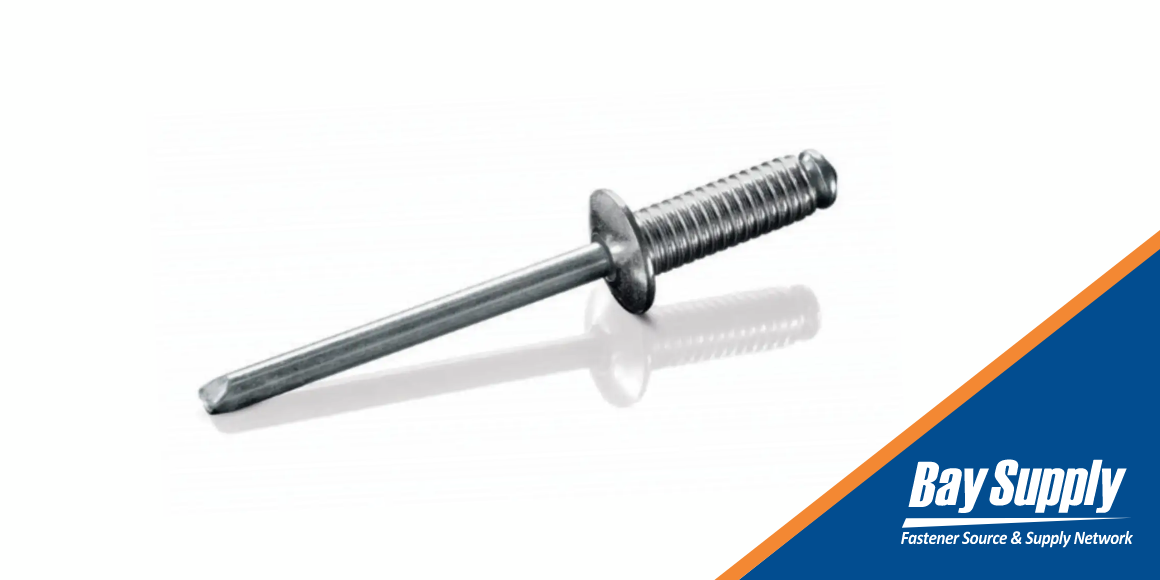
Blind rivets are incredibly useful and have become commonplace in construction, manufacturing, and industrial applications. There are instances when you need a blind rivet that delivers extra strength and won’t pull out of the hole—many of which are ideal applications for grooved blind rivets. Grooved blind rivets are secure in the hole and won’t fail or pull out under stress.
Blind rivets consist of a mandrel with a head and a shaft, which is usually smooth. Grooved rivets have a grooved shaft to form a tighter bond in the pre-drilled hole, which gives them extra strength against pullouts. Learn more about the benefits of using grooved rivets, their design, and applications.
Performing Under Pressure
The design of a grooved rivet is like any other blind rivet. It has a body that fits in a pre-drilled hole and a mandrel that you pull to form a solid joint. As with all blind rivets, you set grooved rivets from one side. What makes grooved rivets different is how they are secured.
With most blind rivets, pulling the mandrel collapses the rivet on the blind side to form a lasting joint. With a grooved rivet, pulling the mandrel expands the rivet shaft inside the hole, forcing the rivet to press against the sides of the hole for a firm grip. Because the rivet body has grooves, expanding the rivet inside the hole creates a firm grip fit that won’t pull out under stress.
Grooved rivets are easy to install using conventional rivet tools. They create a tight fit, making them ideal for applications where the rivet must withstand extreme vibrations, such as factory equipment, farm machinery, and transportation. Grooved rivets are also valuable for securing softer materials, such as fiberglass, wood, and plastics. For construction applications, grooved blind rivets are used in brick and concrete because they don’t pull out.
You are also likely to find grooved blind rivets used in applications such as in the assembly of wooden furniture. Grooved rivets are also tamperproof, so they are often used in public restrooms to prevent vandalism. Since grooved rivet design fills the pre-drilled hole, they also create a waterproof joint and are often used for marine construction, boats, fiberglass tanks, and so forth. Many applications that require extra joint strength can benefit from grooved blind rivets.
Choosing the Right Grooved Blind Rivets
Choosing suitable grooved blind rivet materials ensures a lasting joint. Most grooved rivets have steel mandrels, which gives them added strength. Different sleeve materials are used for different applications.
Aerospace blind rivets and automotive assembly rivets commonly use aluminum sleeves that are strong, lightweight, and corrosion-resistant. Steel- and zinc-plated sleeves offer higher strength and durability and are resilient against moisture, so they are often used for construction, solar installations, and applications where they are exposed to the weather. Copper-nickel alloy sleeves are highly resistant to corrosion, so they are used for marine applications.
In addition to different rivet materials, there are also special rivet coatings. You can find grooved blind rivets treated with specialty coatings. For example, grooved rivets can be treated with zinc plating, anodizing, or plastic coatings for appearance and to prevent corrosion.
When selecting the best grooved blind rivet for an application, consider its various specifications. In addition to the material, you need to match the diameter of the rivet to the hole size. You need a snug fit for grooved rivets to work correctly. You should also choose a head type, such as a domed head, for a finished look. Match the rivet’s grip range to the thickness of the materials so the rivet doesn’t protrude or deliver an inferior joint. Also, consider the tensile strength needed for the application and the shear strength if the joint must stand up to vibration or lateral stress.
Finding New Uses for Grooved Blind Rivets
People continue to find new applications for grooved blind rivets as blind rivet sales increase. Experts predict that the blind rivet market will grow at a compound annual growth rate of 7.48 percent, reaching nearly $157 million in sales by 2030.
More blind rivets are being used with new materials, such as plastics. Plastic parts are replacing metal parts for applications such as automobile bodies and farm equipment. As a result, more manufacturers are adopting grooved blind rivets since they are easy to install and work well with softer materials.
Post-pandemic construction and increased urbanization are also driving a building boom. Contractors are adopting new building techniques, including choosing the correct blind rivet for construction.
When assessing your needs for blind rivets, consider whether using grooved blind rivets will give you the performance you are seeking. Choosing the right type of grooved blind rivets with the proper specifications and the right materials will deliver lasting performance—especially for applications where the joint must resist pullout and stand up to vibration.
Whether you need rivets for applications in aerospace, automotive, marine, construction, or another industry, there is probably a grooved blind rivet that can do the job. The Bay Supply Marketplace has a full range of grooved blind rivets from which to choose. Join the marketplace today to see what rivet options are available for your next job.




Comments